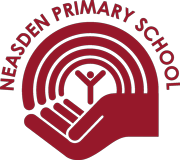Our Approach to Music
At Neasden Primary, Music is taught through the following lenses:
Children will have the opportunity to look at classical, popular music and traditional music from around the world. These are golden threads that run through the curriculum across the primary phase and pupils progress through these strands from introduction to a deep understanding.
The EYFS curriculum provides the building blocks to allow pupils at the beginning of Year 1 to access this curriculum. Pupils will gain significant knowledge of all aspects of the Music National Curriculum, this knowledge is defined into 2 types – substantive knowledge and disciplinary knowledge.
Substantive knowledge focuses on developing children’s skills and knowledge required for them to develop as musicians. This is achieved through deliberate practice and allows children to develop and demonstrate fluency of knowledge. It involves learning about music across a range of historical periods, genres, styles and traditions, including the works of the great composers and musicians.
Disciplinary knowledge in music is the interpretation on the interrelated dimensions of music and how this knowledge is used when singing, playing instruments, using technology to produce music, improvising and composing, to develop creative and original pieces and performances. Children work independently and collaboratively to interpret and combine the dimensions of music to create a specific and desired effect.
For more information regarding the National Curriculum for Music, please click here.
